brake PONTIAC BONNEVILLE 1994 Owners Manual
[x] Cancel search | Manufacturer: PONTIAC, Model Year: 1994, Model line: BONNEVILLE, Model: PONTIAC BONNEVILLE 1994Pages: 290, PDF Size: 14.75 MB
Page 6 of 290
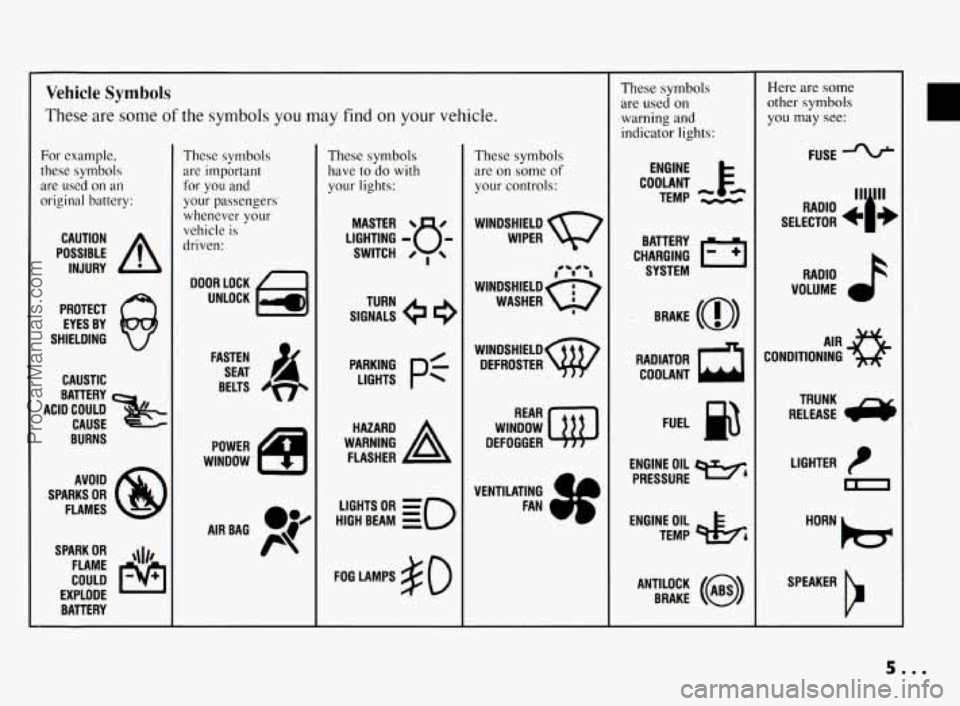
Vehicle Symbols
These are some of the symbols you may find on your vehicle.
For example,
these symbols
are used on an
original battery:
POSSIBLE A
CAUTION
INJURY
PROTECT EYES BY
SHIELDING
CAUSTIC
ACID COULD BATTERY
CAUSE
BURNS
AVOID
SPARKS
OR
FLAMES
SPARK
OR ,111,
COULD FLAME
EXPLODE BATTERY
These symbols
are important
for you and
your passengers
whenever your
vehicle
is
driven:
DOOR LOCK
UNLOCK
FASTEN SEAT
4
BELTS
POWER
WINDOW
'* -- I
These symbols
have to do with
your lights:
SIGNALS e
TURN
HIGH BEAM
OR = =o
FOG LAMPS $0
These symbols
are
on some of
your controls:
WIPER Q7
WINDSHIELD
DEFROSTER
WINDOW
DEFOGGER
VENTILATING
4
FAN (I
These symbols
are used
on
warning and
indicator lights:
COOLANT Fa
TEMP --
ENGINE
CHARGING
I-1
BATTERY SYSTEM
BRAKE
(0)
RADIATOR COOLANT
FUEL
ENGINE OIL
PRESSURE
Wb
TEMP OIL ?b
ANTILOCK (@)
BRAKE
Here are some
other symbols
you may see:
FUSE
11lp RADIO , - -
SELECTOR b I JE
RADIO
VOLUME
CONDITIONING
AIR 43
LIGHTER
m
SPEAKER
b
5.00
ProCarManuals.com
Page 53 of 290
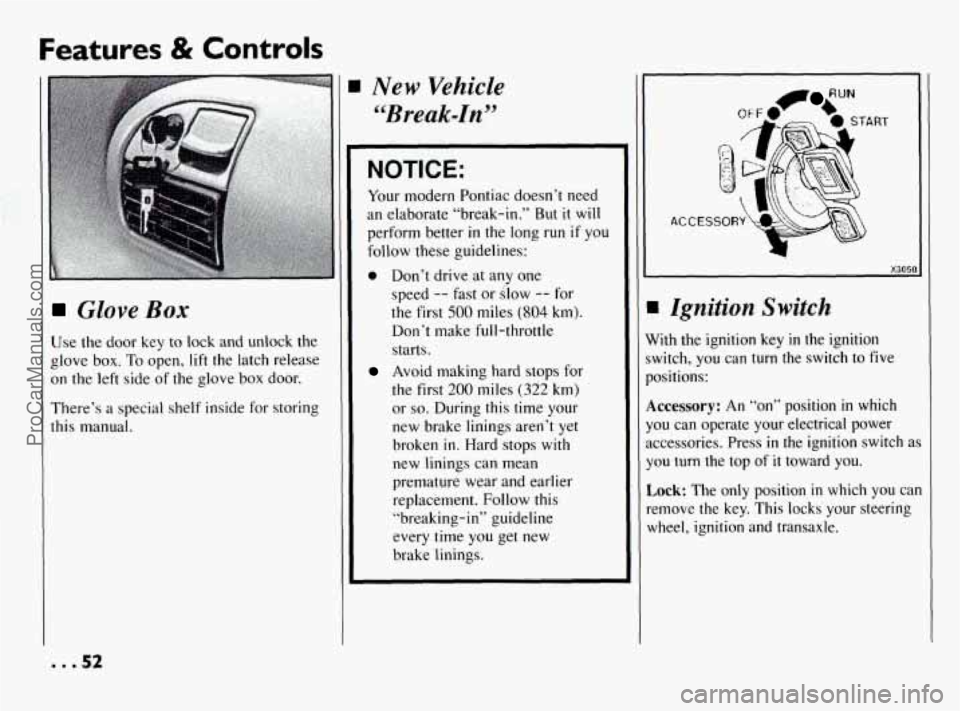
Features & Controls
1 Glove Box
Use the door key to lock and unlock the
glove box.
To open, lift the latch release
on the
left side of the glove box door.
There’s a special shelf inside for storing
this manual.
New Vehicle
“Break-In”
NOTICE:
Your modern Pontiac doesn’t need
an elaborate “break-in.” But
it will
perform better in the long run if you
follow these guidelines:
0 Don’t drive at any one
speed
-- fast or slow -- for
the first
500 miles (804 km).
Don’t make full-throttle
starts.
Avoid making hard stops for
the first 200 miles (322 km)
or so. During this time your
new brake linings aren’t yet
broken in. Hard stops with
new linings can mean
premature wear and earlier
replacement. Follow this
“breaking-in” guideline
every
time you get new
brake linings.
RUN
x305a
I Ignition Switch
Nith the ignition key in the ignition
witch, you can
turn the switch to five
)ositions:
4ccessory: An “on” position in which
’ou can operate your electrical power
Iccessories. Press
in the ignition switch as
rou turn the top of it toward you.
,ock: The only position in which you can
‘emove the key. This locks your steering
vheel, ignition and transaxle.
... 52
ProCarManuals.com
Page 58 of 290
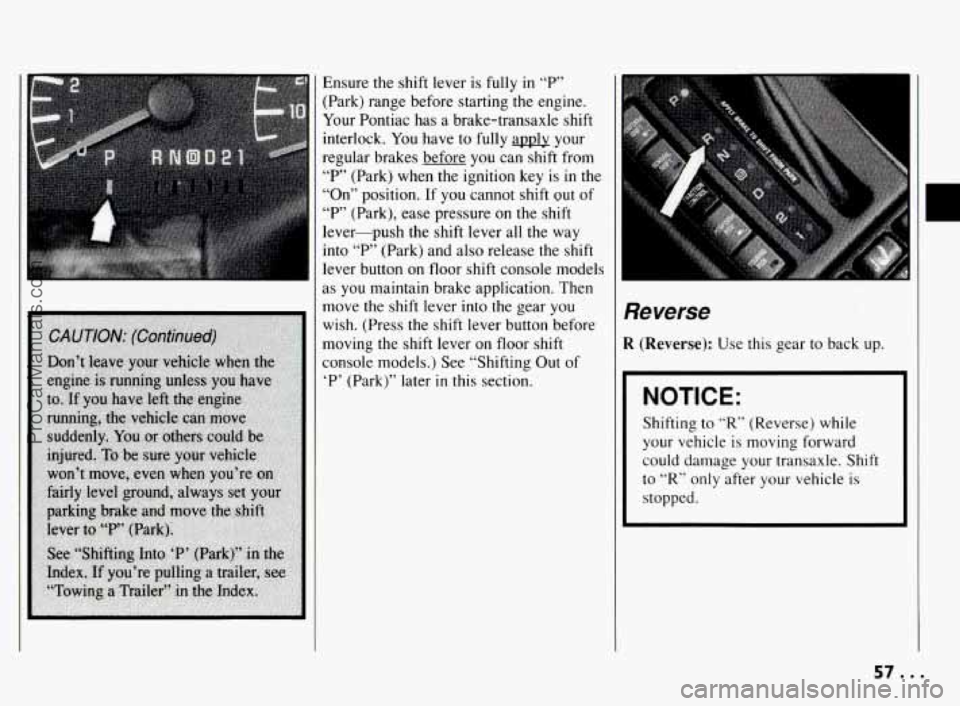
Ensure the shift lever is fully in “P”
(Park) range before starting the engine.
Your Pontiac has a brake-transaxle shift
interlock.
You have to fully apply your
regular brakes before you can shift from
“P,’ (Park) when the ignition key is in the
“On” position. If you cannot shift
gut of
“P’ (Park), ease pressure on the shift
lever-push the shift lever all the way
into
“P” (Park) and also release the shift
lever button on floor shift console models
as you maintain brake application. Then
move the shift lever into the gear you
wish. (Press the shift lever button before
moving the shift lever on floor shift
console models.) See “Shifting Out
of
‘P’ (Park)” later in this section.
Reverse
R (Reverse): Use this gear to back up.
NOTICE:
Shifting to “R” (Reverse) while
your vehicle is moving forward
could damage your transaxle. Shift
to “R” only after your vehicle is
stopped.
57. ..
ProCarManuals.com
Page 61 of 290
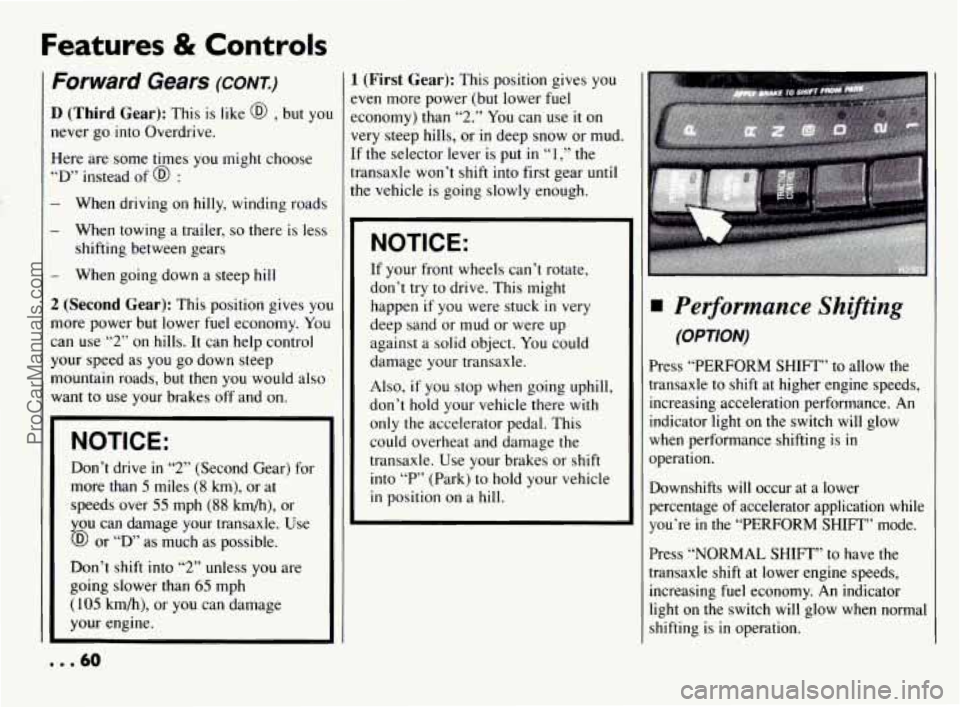
Features & Controls
Forward Gears (CONT)
D (Third Gear): This is like @ , but you
never
go into Overdrive.
Here are some times you might choose
“D’ instead of @ :
- When driving on hilly, winding roads
- When towing a trailer, so there is less
shifting between gears
- When going down a steep hill
2 (Second Gear): This position gives you
more power but lower
fuel economy. You
can use “2” on hills.
It can help control
your speed as you
go down steep
mountain roads, but
then you would also
want
to use your brakes off and on.
NOTICE:
Don’t drive in “2” (Second Gear) for
more than
5 miles (8 km), or at
speeds over
55 mph (88 km/h), or
you can damage your transaxle. Use
@ or “D’ as much as possible.
Don’t shift into “2” unless
you are
going slower than
65 mph
( 105 km/h), or you can damage
your engine.
1 (First Gear): This position gives you
even more power (but lower fuel economy) than
“2.” You can use it on
very steep hills, or in deep snow or mud.
If the selector lever is put
in “1,” the
transaxle won’t shift into first gear until
the vehicle is going slowly enough.
NOTICE:
If your front wheels can’t rotate,
don’t try to drive. This might
happen
if you were stuck in very
deep sand or mud or were up
against a solid object. You could
damage your transaxle.
Also,
if you stop when going uphill,
don’t hold your vehicle there with
only the accelerator pedal. This could overheat and damage the
transaxle. Use your brakes or shift
into
“P’ (Park) to hold your vehicle
in position on a hill.
Performance Shiftins
(OPTION)
Press “PERFORM SHIFT” to allow the
transaxle to shift at higher engine speeds,
increasing acceleration performance.
An
indicator light on the switch will glow
when performance shifting is in
operation.
Downshifts
will occur at a lower
percentage of accelerator application while
you’re
in the “PERFORM SHIFT” mode.
Press “NORMAL
SHIFT” to have the
transaxle shift at lower engine speeds,
increasing fuel economy.
An indicator
light on the switch will glow when normal
shifting
is in operation.
... 60
ProCarManuals.com
Page 62 of 290
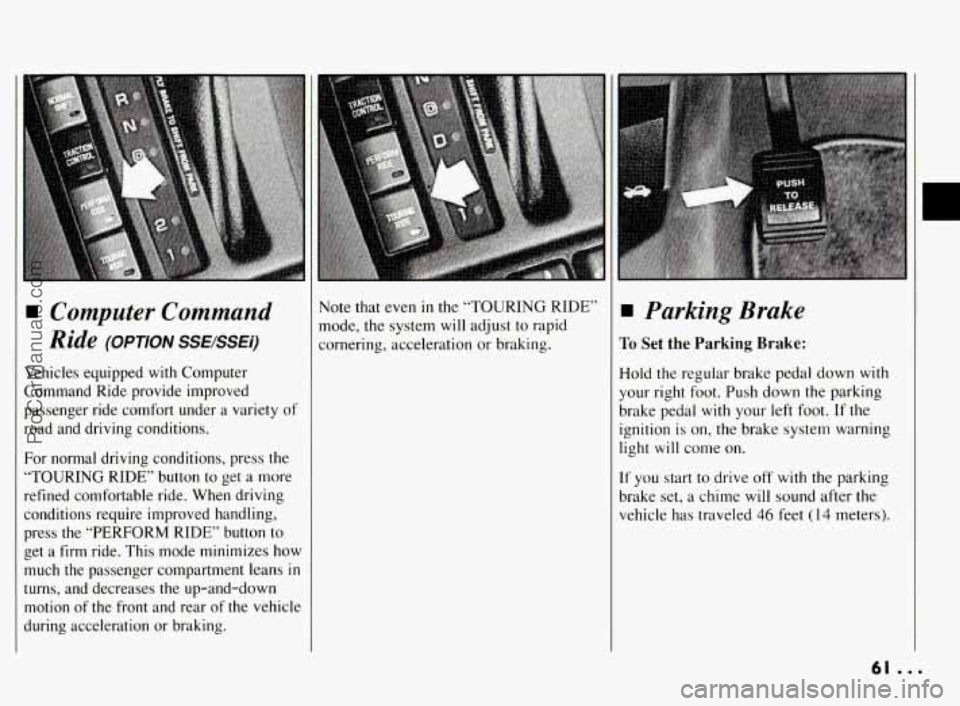
Computer Command
Ride
(OPTION SSEBSEi)
Vehicles equipped with Computer
Command Ride provide improved
passenger ride comfort under
a variety of
road and driving conditions.
For normal driving conditions, press the
“TOURING RIDE” button
to get a more
refined comfortable ride. When driving
conditions require improved handling,
press the “PERFORM RIDE” button to
get a
firm ride. This mode minimizes how
much the passenger compartment leans
in
turns, and decreases the up-and-down
motion of the front and rear of the vehicle
during acceleration or braking. Note that even
in the
“TOURING RIDE”
mode, the system
will adjust to rapid
cornering, acceleration or braking. Parking Brake
To Set the Parking Brake:
Hold the regular brake pedal down with
your right foot. Push down the parking
brake pedal with
your left foot. If the
ignition is on, the brake system warning
light
will come on.
If you start to drive off with the parking
brake set, a chime will sound after the
vehicle has traveled
46 feet (14 meters).
r
61 ...
ProCarManuals.com
Page 63 of 290
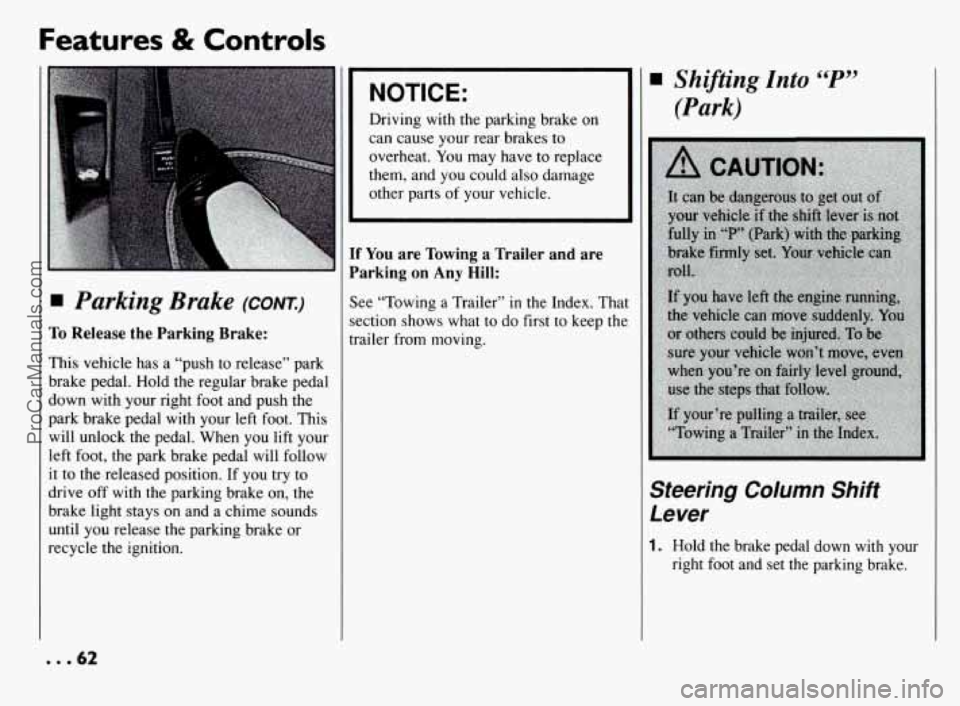
Features & Controls
Parking Brake (CONT.)
To Release the Parking Brake:
This vehicle has a “push to release” park
brake pedal. Hold the regular brake pedal
down with your right foot and push the
park brake pedal with your left foot. This
will unlock the pedal. When you lift your
left foot, the park brake pedal will follow
it to the released position. If you try to
drive
off with the parking brake on, the
brake light stays on and a chime sounds
until you release the parking brake or
recycle the ignition.
NOTICE:
Driving with the parking brake on
can cause your rear brakes to
overheat. You may have
to replace
them, and you could also damage
other parts
of your vehicle.
F You are Towing a Trailer and are
larking
on Any Hill:
ee “Towing a Trailer” in the Index. Tha
xtion shows what
to do first to keep the
+ailer from moving.
Shijiting Into “P”
(Park)
Steering Column Shift
Lever
1. Hold the brake pedal down with your
right foot and set the parking brake.
... 62
ProCarManuals.com
Page 64 of 290
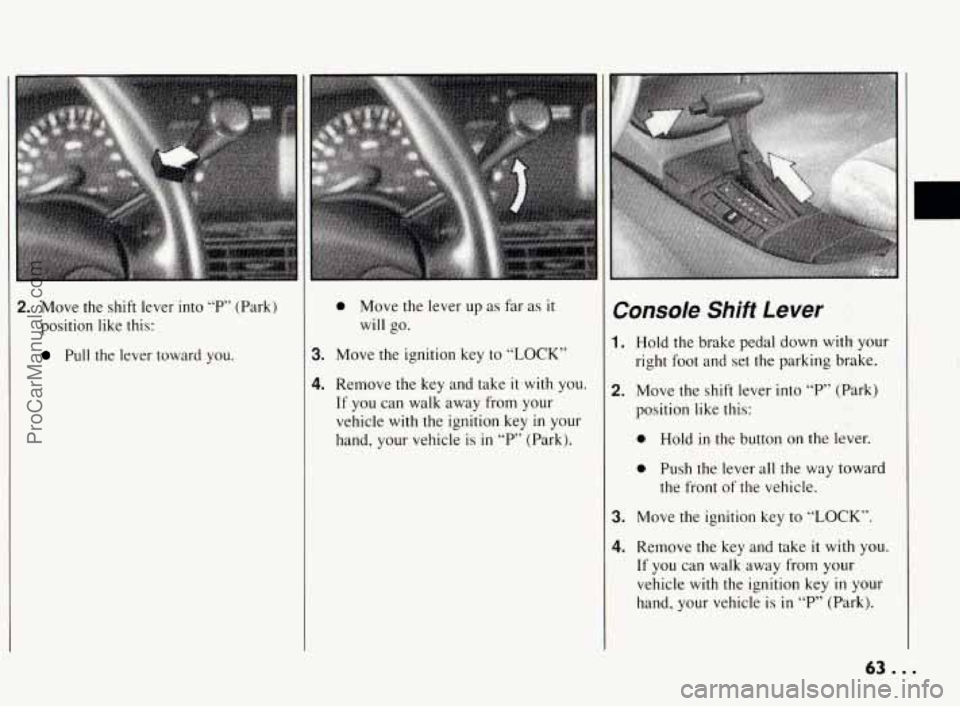
2. Move the shift lever into “P,’ (Park)
position like this:
Pull the lever toward you.
0 Move the lever up as far as it
will go.
3. Move the ignition key to “LOCK”
4. Remove the key and take it with you.
If you can walk away from your
vehicle with the ignition key
in your
hand, your vehicle is
in “P” (Park).
Console Shift Lever
1. Hold the brake pedal down with your
right foot and set the parking brake.
2. Move the shift lever into “P” (Park)
position like this:
0 Hold in the button on the lever.
0 Push the lever all the way toward
the front of the vehicle.
3. Move the ignition key to “LOCK”.
4. Remove the key and take it with you.
If you can walk away from your
vehicle with the ignition key
in your
hand, your vehicle is
in “P” (Park).
c
63 ...
ProCarManuals.com
Page 65 of 290
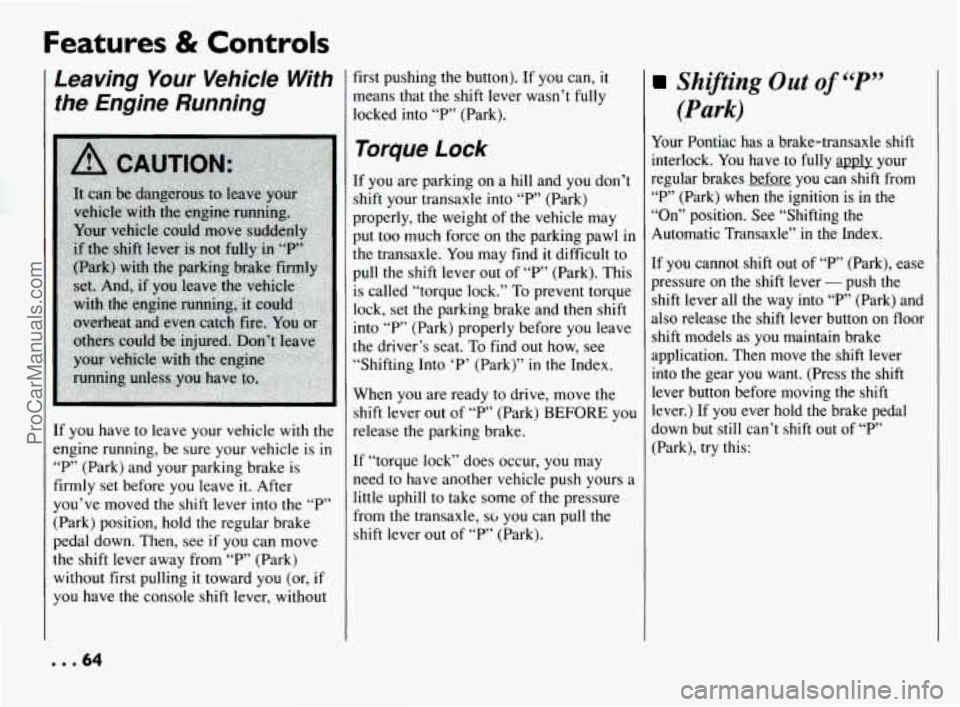
Features & Controls
Leaving Your Vehicle With
the Engine Running
If you have to leave your vehicle with the
engine running, be sure your vehicle is
in
“P” (Park) and your parking brake is
firmly set before you leave it. After
you’ve moved the shift lever into the
“P”
(Park) position, hold the regular brake
pedal down. Then, see
if you can move
the shift lever away from
“P” (Park)
without first pulling it toward you (or,
if
you have the console shift lever, without
... 64
first pushing the button). If you can, it
means that the shift lever wasn’t fully
locked into
“P” (Park).
T~rque Lock
If you are parking on a hill and you don’t
shift your transaxle into
“P” (Park)
properly, the weight of the vehicle may
put too much force on
the parking pawl in
the transaxle. You may find it difficult to
pull
the shift lever out of “F’ (Park). This
is called “torque lock.” To prevent torque
lock, set the parking brake and then shift
into
“P” (Park) properly before you leave
the driver’s seat.
To find out how, see
“Shifting Into ‘P’ (Park)”
in the Index.
When you are ready to drive, move the
shift lever out of
“P’ (Park) BEFORE you
release the parking brake.
If “torque lock” does occur, you may
need to have another vehicle push yours a
little uphill to take some of the pressure
from the transaxle,
so you can pull the
shift lever out of
“P’ (Park).
Shifting Out of “P”
(Park)
Your Pontiac has a brake-transaxle shift
interlock. You have to fully a& your
regular brakes before you can shift from
“P” (Park) when the ignition is in the
“On” position. See “Shifting the
Automatic Transaxle” in the Index.
If you cannot shift out of “P” (Park), ease
pressure
on the shift lever - push the
shift lever ail the way into “P’ (Park) and
also release the shift lever button
on floor
shift models as you maintain brake
application. Then move the shift lever
into the gear you want. (Press the shift
lever button before moving the shift
lever.) If you ever hold the brake pedal
down but still can’t shift out of
“P’
(Park), try this:
ProCarManuals.com
Page 66 of 290
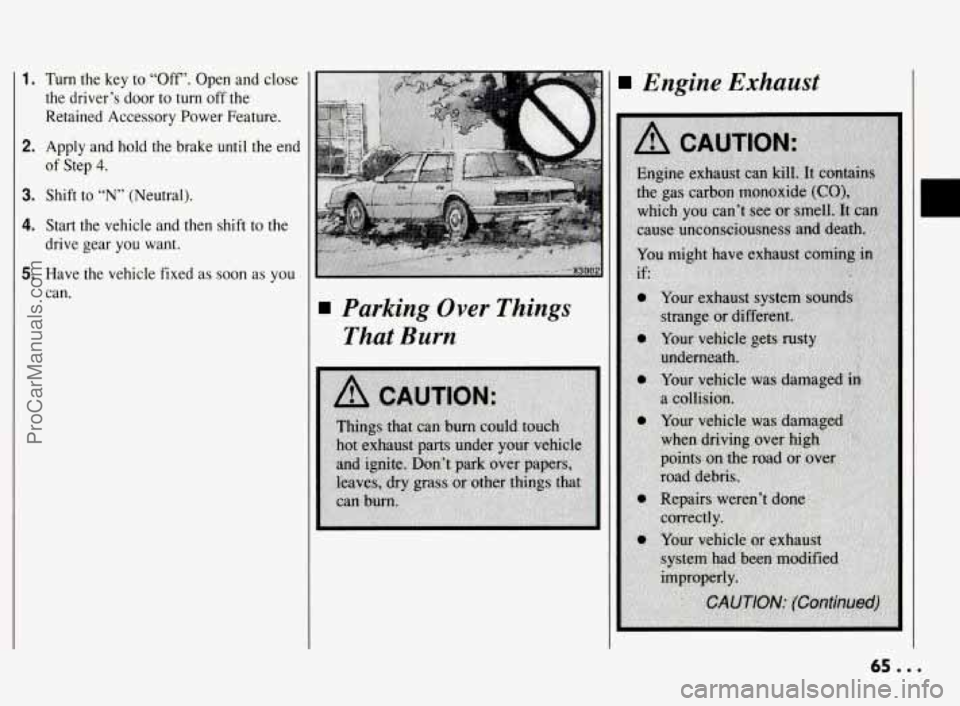
1. Turn the key to “Off”. Open and close
the driver’s door to turn off the
Retained Accessory Power Feature.
2. Apply and hold the brake until the end
of Step 4.
3. Shift to “N” (Neutral).
4. Start the vehicle and then shift to the
drive gear you want.
5. Have the vehicle fixed as soon as you
can.
Parking Over Things
That Burn
Engine Exhaust
65 ...
ProCarManuals.com
Page 73 of 290
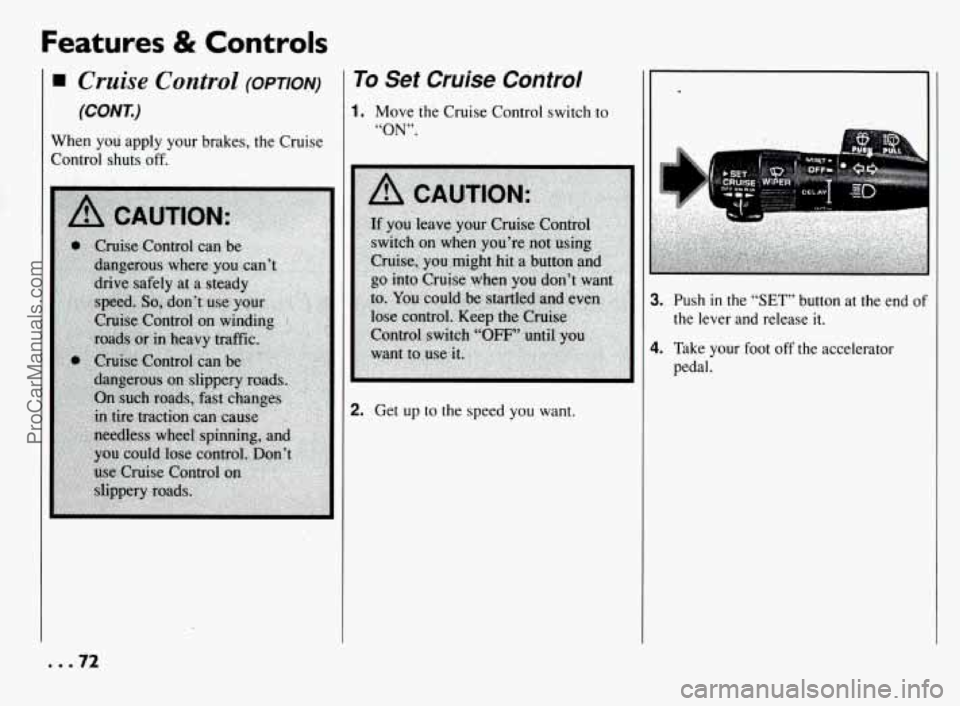
Features & Controls
Cruise Control (OPTION)
(CONK)
When you apply your brakes, the Cruise
Control shuts off.
To Set Cruise Control
1. Move the Cruise Control switch to
“ON”.
2. Get up to the speed you want.
3. Push in the “SE.T” button at the end of
the lever and release it.
4. Take your foot off the accelerator
pedal.
... 72
ProCarManuals.com